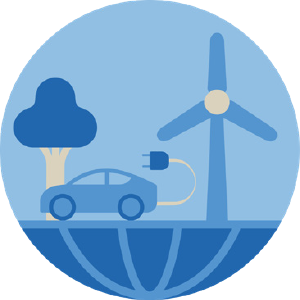Sustainability
The road to net-zero
Sustainability and resiliency drive Zurich North America’s Product Management team as climate change demands attention.
Of the three important pillars in Zurich’s company-wide sustainability commitment — reducing our environmental footprint to help address climate change, securing the future of work and addressing the risks and opportunities in an increasingly digital society — none is more urgent than the first.
The increasing frequency and severity of hurricanes, convective storms, flooding, droughts, wildfires, extreme temperatures and other natural hazards are a reality we see regularly in news reports from around the world. The global movement to achieve a goal of net-zero carbon emissions by 2050 (and keep global warming to no more than 1.5°C above pre-industrial levels to maintain a livable climate) may be mankind’s most important challenge.
Zurich was the first major insurer to sign the United Nations’ Business Ambition for 1.5°C Pledge in May of last year and is a founding member of the Net-Zero Insurance Alliance. The company takes pride in being a carbon-neutral organization since 2014. Zurich has targeted reducing carbon emissions from its 2019 levels by 50% by the year 2025 and by 70% by 2029. It has also committed to fully decarbonizing its investment portfolio by 2050, using 100% renewable power in all its facilities by the end of 2022, and using only electric vehicles in its global car fleet by the end of 2029.
Making such strong environmental commitments, however, doesn’t just mean simply ending certain business practices ... it also means opening doors to others, all the while keeping customers’ needs front and center.

Moving forward with our customers
David Edsey is Climate Director - Product Management for Zurich North America, and he and his colleagues are helping lead the charge in finding, developing and ultimately implementing the right coverages and tools for customers in a changing world. Making that progress also means helping customers whose businesses rely on thermal coal, oil sands and oil shales shift to more environmentally friendly outputs and practices. Product development has to keep the full scope of an insured’s business in mind to ease a transition to greener business models and/or energy suppliers.
Edsey explains, “As we move on this commitment to reduce the carbon-intensity of our underwriting portfolio, we also have to offer services and advice to our customers to move with us to get to net-zero by 2050 in order to avoid the worst effects of climate change, which we’re now seeing glimpses of with the droughts and severe heat and wildfires out west.
“Zurich is committed to supporting the emerging and existing technologies and industries the world will need to reach net-zero, and correspondingly providing insurance capacity for those industries and finding the opportunities in emerging green market segments.”
Additionally, as a provider of risk management products and services, Zurich is committed to assisting its customers in improving their resiliency to the increased risks presented by climate change. Zurich's Risk Engineering arm has been rebranded as Zurich Resilience Solutions in part to focus on this effort.

Growth in renewables
Business resiliency and sustainability can and do work hand-in-hand. Companies worried about the reliability of solar or wind power may find greater assurance in using those renewable energy sources as they learn about advancements in battery storage technologies, like utility-scale batteries that can store significant excess electricity generation.
Maximizing low- and zero-carbon energy sources is an important pathway to moving away from coal, oil, natural gas and other high-carbon energy sources, especially since, as Edsey points out, renewable sources already help power a significant portion of the national grid.
“Solar, wind, hydro and nuclear together provide about 40% of U.S. electricity generation, with nuclear being about half of that,” he explains.
Nuclear energy, of course, is a much-debated solution per safety concerns about radioactive waste and fear of meltdowns. It is, however, a source already in wide use that does not produce direct carbon dioxide emissions or air pollution, and so may be a necessary energy source in the world's race to net-zero emissions. Additionally, advances in reactor safety, recycling of nuclear fuel, the development of safer nuclear fusion technology (rather than fission), and deployment of small modular reactors may forge a new path for this industry.
Wind and solar power are sectors primed for explosive growth. Today, wind power generates about 8% of U.S. electricity, while solar only accounts for about 3%. However, federal and state commitments to renewable energy and a major drop in the costs of solar panels are already incentivizing increasing investment in these sectors. (Since 2014, the average cost of solar PV panels has dropped nearly 70%.1) Edsey says that based on projections by the National Renewable Energy Laboratory, renewable energy sources (excluding nuclear) are projected to rise to account for anywhere from 31% to 83% of U.S. electricity generation by 2050.
That expected fast changeover is understandable when you see how continued fossil fuel use is compounding our climate crisis. Zurich is one of many insurers who have stopped covering coal businesses as the long-term view on its use has become clear. Coal accounts for 46% of carbon emissions worldwide. “There is definitely an urgency behind ending the use of coal as a source of energy,” Edsey says.

Alternative energy sources
While wind and solar will be major factors in building a more sustainable future, there are other widely deployed technologies that can contribute. Edsey points to a few worth keeping an eye on:
Tidal energy is powered by surges of ocean water during the rise and fall of tides. Edsey says this industry is “still in its infancy,” but points to commercial-sized tidal power plants in France, Northern Ireland and South Korea as examples where it has been effective. There are, however, concerns over how tidal energy disrupts sea life.
Geothermal power plants use high-temperature (between 300°F and 700°F) hydrothermal reservoirs to draw energy and some see promise with this source. Currently, Edsey says the U.S. electric grid gets only about a half-percentage point of its energy from geothermal power. Geothermal heat pumps, which rely on the constant temperatures beneath the earth's surface to heat and cool buildings, may provide a much-needed carbon-free alternative to natural gas and oil heating sources.
Biomass energy uses renewable organic material from plants and animals to create biofuels like ethanol. Biomass is actually one of the oldest forms of energy generation, but its traditional use (combustion of biomass in wood, animal waste and traditional charcoal) is very different from modern bioenergy technologies like liquid biofuels, bio-refineries and more.2 Edsey reports only about 1.4% of U.S. energy comes from biomass, but as research and development pushes forward advancements in its use, demand could grow.
Hydrogen fuel cells produce electricity through a chemical reaction between hydrogen and oxygen, with the only exhaust being water. The technologies to harness pure hydrogen, however, are still developing. It’s a sector Edsey sees as emerging, but it may currently be too expensive to become quickly competitive with other renewables.

Keeping carbon under control
In addition to using renewable energy sources to lessen the amount of carbon emitted into the atmosphere, new and evolving practices and technologies are also being put to use to remove carbon from the atmosphere. Edsey highlighted two of them:
Carbon capture and storage (CCS) captures CO2 from a point of emission or directly from the air, condensing it into a liquid that is injected thousands of feet underground into a porous geological formation that can absorb liquid carbon and hold it indefinitely. Related industries are also being developed to utilize captured carbon in building materials (i.e., cinder blocks) rather than store it underground. Edsey says CCS technology has been successfully commercially deployed since 1996 and the market is expected to grow. The U.S. government has incentivized the growth of this industry through tax credits. Employing CCS technology is a potential way carbon-intensive industries (e.g., oil, gas, petrochemical, steel) may be able to reach net-zero emissions without fundamental changes to their operations.
Natural climate solutions, including such practices as forest restoration, agroforestry, regenerative agriculture and others, have been estimated to have the potential to deliver approximately one-third of the global greenhouse gas emissions avoidance and/or reductions needed to achieve 2030 and 2050 reduction goals.3 In particular, regenerative agriculture is a wholistic farming land management practice to capture carbon in the soil, rebuild soil organic content and increase water-holding capacity, which sequesters carbon and eliminates the need for chemical fertilizers and pesticides.
“If you look at carbon maps from outer space, the highest concentration of carbon in the atmosphere in the northern hemisphere takes place around March through April when the farmers are tilling the soil,” Edsey explains. “Regenerative agriculture basically eliminates that tilling and injects the seeds into the ground. Some proponents of regenerative agriculture believe that by keeping the carbon in the soil, it could solve the global warming crisis ... that there’s that much capacity within the earth's farmed soil to capture that much carbon.”
How new technologies, renewable energy sources and emerging markets will impact Zurich’s current and future insurance offerings and risk-mitigation services can vary from industry to industry and among different business types within each industry. Though Edsey is on the Product Management team, he knows the importance of risk consultation across the company to get customers to a more sustainable place.
“Zurich Resilience Solutions is building out their capacity to advise our customers in how to make their operations less carbon-impactful and more resilient to the effects of climate change,” Edsey explains.
These capabilities include providing insight into the protection of alternative energy sources, suggestions on building envelope design to support carbon reduction and construction to withstand natural hazard events. The team can also complete an analysis of climate-based risks on locations as they operate today and estimate future climate risks incorporating expected changes in the environment. This analysis can support strengthening current site construction/safeguards and assist in determining future locations where exposure to natural hazards may be lower. Zurich Resilience Solutions is adding natural hazard specialists to their team to provide consulting in this arena.
These capabilities will align with the evolution of Zurich’s environmental sustainability commitments and product and service offerings ... all part of meeting the company’s commitment to help shape a brighter future.

Zurich is ready to work with new and existing Programs on exploring coverages and services to help Programs customers in transitioning their businesses to low-carbon operations and strengthening their resiliency to increasing climate risks. We welcome having conversations with our Program Administrators about strategies to share with customers.
- Office of Energy Efficiency & Renewable Energy. “Solar Energy in the United States.” Accessed 30 July 2021.
- International Renewable Energy Agency. “Bioenergy.” Accessed 30 July 2021.
- “Nature and Net Zero.” World Economic Forum, McKinsey & Company. May 2021.
_____________
8 PROGRAM LEADER